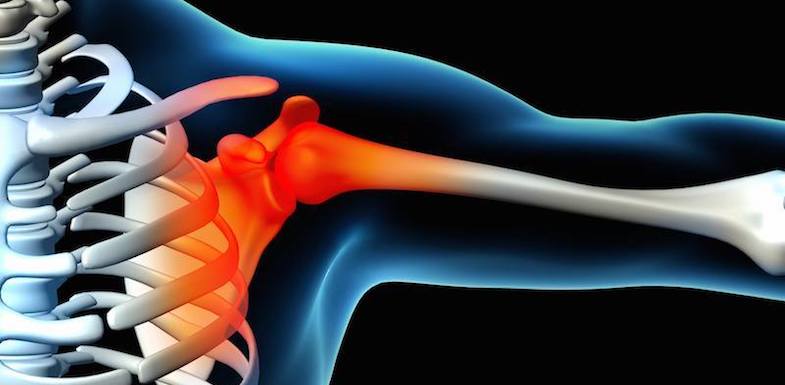Shoulder pain is an issue that affects between four and 26% of people in the U.S. every year. This highly mobile part of the body consists of multiple joints that are responsible for everything from lifting our arms over our heads to hugging our loved ones. If you are considering visiting a chiropractor for shoulder pain, here’s what you need to know (and how it can help!).
The most common shoulder pain causes
Your shoulder joint – also referred to as the shoulder girdle – is a highly complex, incredibly mobile structure. It consists of two main joints (four joints total):
- Acromioclavicular joint: The place where the clavicle (collarbone) and the shoulder blade (scapula) meet in the back of the body
- Glenohumeral joint: What most people consider the shoulder, the area where the humerus (the upper arm bone) inserts into the socket of the shoulder (the glenoid cavity)
These two joints are surrounded by a complex configuration of muscles, ligaments, and tendons, including the rotator cuff. The rotator cuff includes four muscles: the supraspinatus, infraspinatus, teres minor, and the subscapularis. These muscles not only help keep the humerus nestled into the glenoid cavity, but also help you to raise your arms above your head.
Tendons attach muscles to bones, and ligaments connect muscles to each other, allowing for smooth movement. The shoulder joint capsule itself is lined with labrum, a soft tissue that molds to fit the head of the humerus. The glenohumeral joint also has bursa, a fluid-filled sack that eases movement and absorbs shock.
Finally, the nerves of your shoulder all pass through the armpit in a large complex called the brachial plexus. These nerves are responsible for all movement and pain signaling in the arms, hands, and shoulder.
Shoulder pain can occur at any time, sometimes worsening at night as the joint stiffens. Pain may feel like a dull ache or burning inside of the shoulder joint. Others may feel a sharp pain when moving in several different areas that could include the shoulder, the middle back between the shoulder blades, the neck, and the arm.

What causes shoulder pain?
Because of the complexity of the shoulder joint, there are a variety of shoulder pain causes. Here are eight of the most common. Understanding these major causes can help you understand which ones are most effectively treated by a chiropractor for shoulder pain.
1. Frozen shoulder
Also referred to as adhesive capsulitis, frozen shoulder is a condition when the connective tissue in the shoulder becomes thick and tightens around the shoulder joint.
This condition is most common after an injury that restricts shoulder movement for a period of time.
2. Dislocated shoulder
Dislocated shoulder is an unfortunately common contact sports injury. The humerus pops out of the glenoid cavity. This can cause initial pain, but it can also be accompanied by numbness if nerves are affected.
Unfortunately, a shoulder that dislocates once is at risk for repeated dislocations.
3. Pinched nerve
If there are mechanical issues in your neck or in the shoulder joint itself, these may result in pinched or impinged nerves.
This pressure on any nerve, either the main branching one or smaller nerves that emanate from it, can cause pain, numbness, and tingling in the hands, arms, and shoulder.
4. Rotator cuff injury
Ranging from minor irritation to a full-on tear, a rotator cuff injury can be caused by a slow deterioration of the muscles due to mechanical use, or it can occur with sudden trauma (e.g., as a result of a car accident).
Rotator cuff injuries are among the most common types of shoulder pain.
5. Arthritis
A conservative estimate of those affected by arthritis in the U.S. is 54 million adults. This can be a wear-and-tear condition like osteoarthritis, or it may be related to an autoimmune disorder like rheumatoid arthritis.
Regardless of the cause, arthritis can cause inflammation and pain in your shoulder that restricts movement and decreases your shoulder’s range of motion.
6. Shoulder bursitis
When the fluid-filled shoulder capsule becomes irritated or inflamed, you may develop shoulder bursitis. This condition occurs most frequently where the humerus connects in the glenoid cavity.
Bursitis pain can increase to the point where movement of your shoulder becomes nearly impossible. This restricted range of motion may also lead to frozen shoulder.
7. Tendonitis
Shoulder tendonitis is a specific type of inflammation and irritation in either the biceps or rotator cuff tendons. This is often experienced by people who have occupations with repetitive motions, or in professional athletes who repeat the same motion in the course of practice or play.
Tendon injuries are notoriously painful and slow-healing.
8. Injury (strains and sprains)
Injury to the shoulder is a common cause of shoulder pain. Working hard in the garden, playing too enthusiastically in your weekend pick-up basketball game, or lifting something heavy during a move can all cause shoulder pain.
How can a chiropractor for shoulder pain help?
Fortunately, chiropractic care for shoulder pain can be an effective, side-effect-free way to address many of the above conditions. Consider the following.
- A 2012 study of frozen shoulder saw 82% of cases either completely resolved or at least 75% resolved with care
- Chiropractic adjustment for shoulder impingement can be effective to relieve pain, weakness, and numbness in the extremities
- In cases where a shoulder dislocation becomes recurring shoulder instability, seeing a chiropractor for shoulder pain can help reduce the chance of recurring shoulder dislocation
- Chiropractic for rotator cuff pain is a conservative pain management and rehabilitation strategy that has some good evidence of effectiveness
Seeing a chiropractor for shoulder pain is an excellent way to explore conservative treatment options to improve range of motion and treat pain.
How does chiropractic care work?
Your chiropractor focuses on the skeleton and the way it aligns to help move the body through its daily tasks. By performing a variety of specific adjustments, both for overall alignment and to treat an acute condition, your chiropractor can help relieve pain caused by imbalance or injury to your skeleton.
In addition to being an effective alternative to more invasive treatments of shoulder pain, chiropractic care has few to no side effects and does not interact negatively with other treatments. Most chiropractors work with your other healthcare providers to coordinate their care for the best possible outcomes.
Chiropractic techniques
When treating shoulder pain, your chiropractor will design a treatment that may consist of hands-on adjustments or adjustments using specials tools or tables. The most common types of chiropractic adjustments for shoulder injuries in particular include the following.
- Articulatory: This type of chiropractic technique focuses on improving the range of motion in a specific joint – in this case, the shoulder joint. During your session, your chiropractor will move the joint through its existing range of motion while applying force to gradually increase it and improve shoulder mobility.
- Myofascial release: Myofascial release focuses on releasing tight connective tissues around the shoulder. These could be causing or contributing to frozen shoulder and other painful conditions that decrease your shoulder’s range of motion.
- Cervical spinal manipulation: The cervical spine can cause referred shoulder pain. Cervical spinal manipulation focuses on balancing the cervical vertebrae to decrease pain from pinched nerves.
- Functional technique: Functional technique is also used to improve a joint’s range of motion and decrease stiffness. Your chiropractor moves the shoulder to the end of its range of motion and then holds it there until they feel a release. Over time, this gentle pressure can loosen the joint capsule and relieve your stiffness.
In addition to the above techniques, your chiropractor may also use the direct thrust technique. While not specifically aimed at shoulder injury or other conditions, this technique uses a short, swift movement to bring the spine back into alignment. As chiropractors consider the whole skeletal system when designing a treatment plan, this type of chiropractic adjustment may be necessary to fully balance your body.
You can learn a bit more about different techniques in the following video.
What can I expect when visiting a chiropractor for shoulder pain?
Your first visit to the chiropractor starts by them taking a complete medical history and conducting a physical exam. If you are visiting a chiropractor for shoulder pain, they will move the joint through its range of motion and try to determine the area that is out of alignment.
To help with this, your chiropractor may order X-rays to determine if there are any other underlying issues before proceeding with treatment.
Your comfort is important during this whole process. There will be ample time to get all of your questions answered in your initial consultation. If you have never received chiropractic care before, your doctor will take the time to make sure you understand the techniques they plan to use before they begin.
Does chiropractic care hurt?
Many first-time patients are most concerned about pain when receiving an adjustment. After all, they may have only heard rumors about “back cracking,” a misnomer that nevertheless does not sound pleasant!
The truth is that patients rarely, if ever, experience discomfort when receiving chiropractic care. You may feel pressure when your doctor is using articulatory or functional techniques, but the goal is not to cause pain but to relieve it.
Some patients may experience mild muscle soreness after treatment. This generally occurs when you involuntarily clench your muscles in anticipation of movement and should be minor and temporary.
The best way to ensure a pain-free adjustment is to follow your doctor’s instructions during your appointment, breathing in and out and consciously relaxing.
How quickly will I feel better after?
As a general rule, it takes between one and four weeks to see improvements in your condition. This time frame for pain relief varies widely depending on the following:
- The condition treated
- How often you come for treatment
- Other underlying health conditions
- General overall health at the start of treatment
- Compliance with other treatment (e.g., physical therapy)
All that being said, some patients experience relief from pain after just one treatment. Your doctor can answer all of your questions concerning your specific treatment timelines and expectations for relief at your initial appointment.
Are there any side effects?
The research is in: side effects of chiropractic care are described as “rare and benign.” These rare and benign side effects may include:
- Discomfort in the treatment area
- Dizziness
- Fatigue
- Headache
- Nausea
It’s important to note that when these side effects are present, they generally occur at the very beginning of treatment and are less common as treatments continue.
Finally, while driving yourself to and from your chiropractic treatments is generally safe, it’s important to talk with your doctor about your concerns. Still not sure? Get a ride to your first appointment and see how you feel after.
Learn more
Seeing a chiropractor for shoulder pain is just one aspect of a comprehensive pain management plan. At Arizona Pain, we can develop individualized treatment options just for you.
